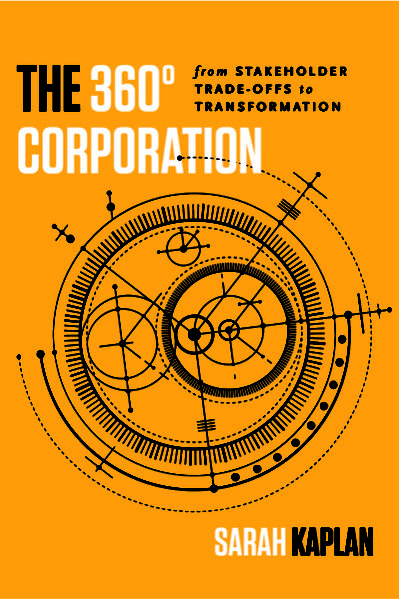While the main objective of a for-profit organization is obvious — profit — concerns about environmental impact, sustainability, income inequality, gender and racial diversity, and more are increasingly spurring debate about the role of business in society. In a best-case scenario, innovation creates value not just for shareholders, but for multiple stakeholders including customers, communities, and employees. But the question is, how can companies balance demand for corporate responsibility against stockholder expectations that they maximize profit? On this episode of Mastering Innovation on SiriusXM Channel 132, Business Radio Powered by The Wharton School, Mack Institute Senior Fellow Sarah Kaplan, author of The 360° Corporation: From Stakeholder Trade-offs to Transformation (2019), discusses how businesses can approach trade-offs as sources of innovation, creativity, and even long-term profitability.
An excerpt of the interview is transcribed below. Listen to more episodes here.
Transcript
Harbir Singh: We live in a world where people have to make choices. Tell us about the trade-offs you’re talking about, an example of how people have to cope with the issue of stockholder interest versus broader stakeholder or societal interest.

Sarah Kaplan: You gave some really good examples in the introduction about trade-offs. Other things we might think about are things like using same-day delivery or next-day delivery when we order products on Amazon. That service is great for us as consumers, and it’s great for Amazon because it helps them sell more products. But it’s also contributing to road congestion, pollution, and it’s unclear that these jobs are really great jobs for the delivery people either. And so, we’re trading off our convenience as consumers or sales by Amazon for these other things. That would be one example.
Another example might be investing in pollution control devices if you run a factory. That is going to be great for improving the environment, but might be highly costly and might create a trade-off with a stakeholder. Or think about high-performance athletic shoes. We love our athletic shoes, our Nike shoes, and they look cool and they perform well, but to make that happen, you have to use toxic glues to hold the shoe together so that it withstands the use you put it to in playing your sports. That could be both bad for the environment and also for the workers who assemble the shoes.
So these are examples of standard ways of doing business which have impact on other stakeholders that often we don’t even think about. Economists would call these externalities, meaning they are outside of the business. But I’m saying that actually, they’re not external, because companies are an important part of society. We need to think about that. Then the question becomes, what do you do about it once you realize that there are not infinite resources, and you have to actually look at these trade-offs and figure out, “What do I do about the challenge that’s being created through these trade-offs?”

Singh: That’s a very interesting point. What you’re talking about is for executives, in making new decisions or changes in product or business models, to think systemically and not just narrowly about their own corporation. That would be one issue.
The other issue is understanding individual actions versus collective actions in an industry and knowing that people are so tied up in competing with the immediate rival. You take, for example, same-day delivery. All the companies in retail who have online businesses are trying to accelerate the delivery. As you said, that causes, first of all, a carbon footprint that may be more than one would expect, but also congestion, traffic problems, and accidents.
I’ll give you an example I found very interesting. I was in India in December, and this delivery truck came. It was a residential neighborhood, and the truck came against the traffic on a one-way street and stopped. Then the driver ran out, dropped a package, and came back. Of course people were upset, and the driver just gave them a few choice words, backed up the truck, and left. And this was a FedEx delivery guy. So, this is the consequence of the globalization of delivery models, where in some places, the rules are far less enforced, and it can be dangerous for society.
“The first mistake that companies make is not knowing what their trade-offs are.”— Sarah Kaplan
Kaplan: Right. One of the things that I talk about in the book is the four modes of action in terms of what companies can do, and these modes of action are coupled with four mistakes. The first mistake that companies make is not knowing what their trade-offs are. That is my mode one: the idea that you can’t do anything unless you’ve actually thought systematically about what trade-offs you’re creating.
Now, you mentioned earlier the fact that we don’t have unlimited resources. In the face of that, a lot of people feel like the first thing they have to do is make the business case for action, because they’re not going to be able to do anything otherwise. You can see this happening all over the place, whether it is the business case for diversity or the business case for sustainability.
What I suggest in the book, based on academic research, is that if you start with the business case, you can actually limit the possibilities that you’re thinking about. In fact, you may need to do something quite transformational if you’re going to deal with that congestion or danger or other issues. So, in the book, I argue against using the business case as a starting point. I’m not saying that there aren’t financial benefits over the long run, because I actually think there are. However, I’m saying that if you have to have the business case first, you’re going to limit yourself to incremental kinds of solutions.
About Our Guest
Sarah Kaplan is Distinguished Professor, Director of the Institute for Gender and the Economy, and Professor of Strategic Management at the Rotman School of Management at the University of Toronto. She is a co-author of the bestselling business book, Creative Destruction, as well as Survive and Thrive: Winning Against Strategic Threats to Your Business. Her latest book, The 360° Corporation: From Stakeholder Trade-offs to Transformation appeared in 2019. Her research has covered how organizations participate in and respond to the emergence of new fields and technologies in biotechnology, fiber optics, financial services, nanotechnology and most recently, the field emerging at the nexus of gender and finance. She recently authored “Gender Equality as an Innovation Challenge” (2017) in the Rotman Management Magazine, “The Risky Rhetoric of Female Risk Aversion” (2016) in the Stanford Social Innovation Review, “Meritocracy: From Myth to Reality” in the Rotman Management Magazine (2015), and “The Rise of Gender Capitalism,” in the Stanford Social Innovation Review (2014). Her current work focuses on applying an innovation lens to understanding the challenges for achieving gender equality.
Formerly a professor at the Wharton School, University of Pennsylvania (where she remains a Senior Fellow), and a consultant and innovation specialist for nearly a decade at McKinsey & Company in New York, she completed her doctoral research at the Sloan School of Management at the Massachusetts Institute of Technology (MIT). She has a BA with honors in Political Science from UCLA and an MA in International Relations and International Economics from the School for Advanced International Studies, Johns Hopkins University.



